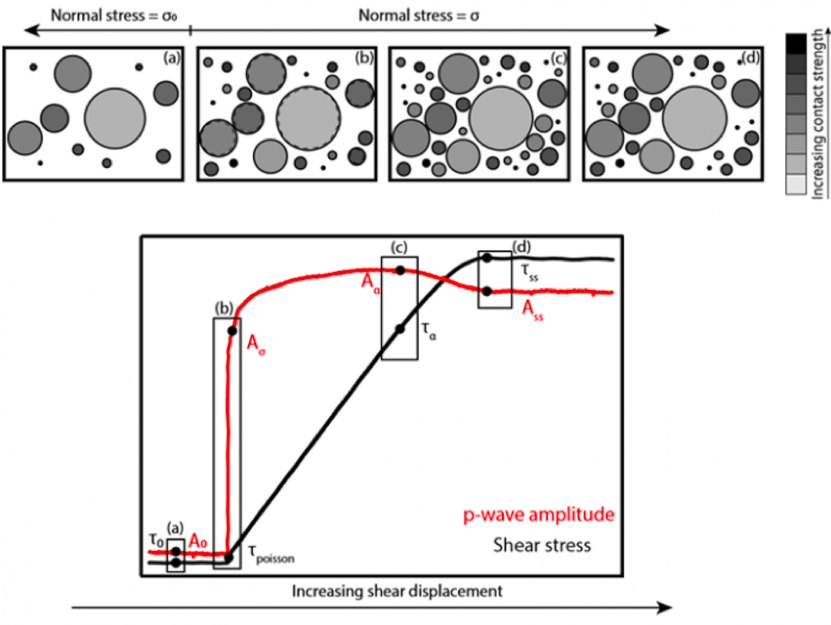Laboratory Study Probes Triggering Mechanisms of Earthquakes
A new experimental technique traces the state of a shearing fault gouge and shows for the first time how friction of a fault surface can change as a function of varying normal stress.
SOURCE: Journal of Geophysical Research: Solid Earth

Shear contact strength and shear stress as a function of a step increase in normal stress, in laboratory tests. The model in the upper part of figure shows a plan view of the friction surface contact strength as indicated by circles of different sizes and gray shading. The diagram in the lower part of the figure shows how shear stress (black curve) increases as a function of the step increase in normal stress (not shown); the ultrasonic p-wave amplitude (red curve) effectively proxies for the development of shear stress and contact surface friction of the sliding granite blocks. Credit: Shreedharan et al. [2019], Figure 18
Changes in normal stress on a fault surface can occur during an earthquake, which may influence the frictional strength of the activated fault. However, the nature of changes in surface friction due to rapid increases or decreases in normal stress is poorly understood. Shreedharan et al. [2019] investigated the effect of changes in normal stress on shear friction in laboratory experiments to better understand this relationship.
Experiments were conducted by sliding blocks of granite against each other, while monitoring the shear stress response and how well the surfaces are in contact during sliding. The contact between the blocks could be monitored in-situ during experiments using ultrasonic waves. A strong correlation was found between the amplitude of ultrasonic waves and the applied normal stress, which the authors used to propose a model that accounts for the effect of normal stress perturbations on the contact behavior between sliding rock surfaces. The amplitude of ultrasonic waves furthermore reflected the development of surface friction during shear after the change in normal stress.
A micromechanical multi-contact model is used to qualitatively explain the evolution of frictional strength as a function of normal stress changes, which helps understand the triggering mechanisms of earthquakes.
Citation: Shreedharan, S., Rivière, J., Bhattacharya, P., & Marone, C. [2019]. Frictional state evolution during normal stress perturbations probed with ultrasonic waves. Journal of Geophysical Research: Solid Earth, 124. https://doi.org/10.1029/2018JB016885
—Bjarne S. G. Almqvist, Associate Editor, JGR: Solid Earth
AGU发布最新国外工作学习机会
1. Postdoctoral Research Associate Position on Southern Ocean Climate Dynamics
Princeton, NJ
Open DOE
University of Arizona
2. Ph.D. Opportunities in Hydrogeology and Hydrogeochemistry
Saskatoon, Saskatchewan
University of Saskatchewan
https://findajob.agu.org/job/8010807/ph-d-opportunities-in-hydrogeology-and-hydrogeochemistry/
3. Applied Geophysics Research Scientist (Energy Geosciences Division)
Berkeley, California (US)
Lawrence Berkeley National Laboratory
4. Research Associate in Isotope Geochemistry
140 Commonwealth Avenue, Chestnut Hill MA 02467
Hiring range: $48,000-$55,000; salary commensurate with relevant experience
Boston College
https://findajob.agu.org/job/8010806/research-associate-in-isotope-geochemistry/



